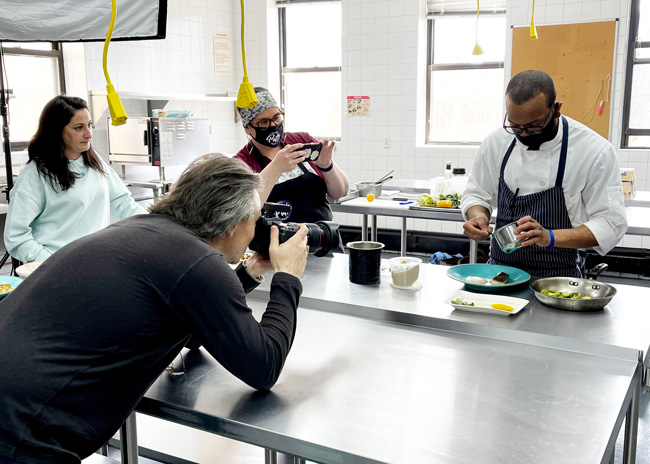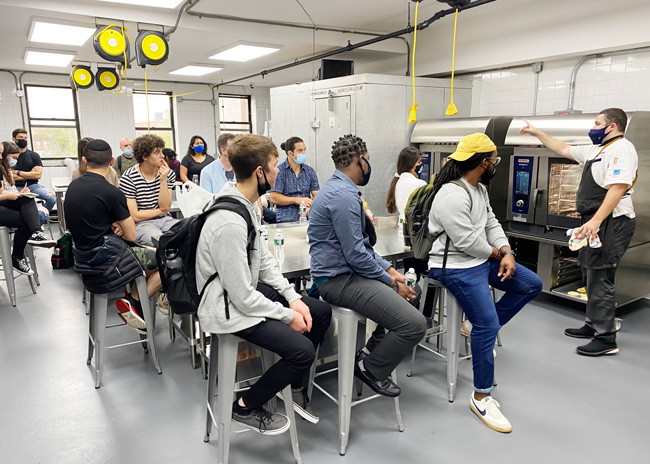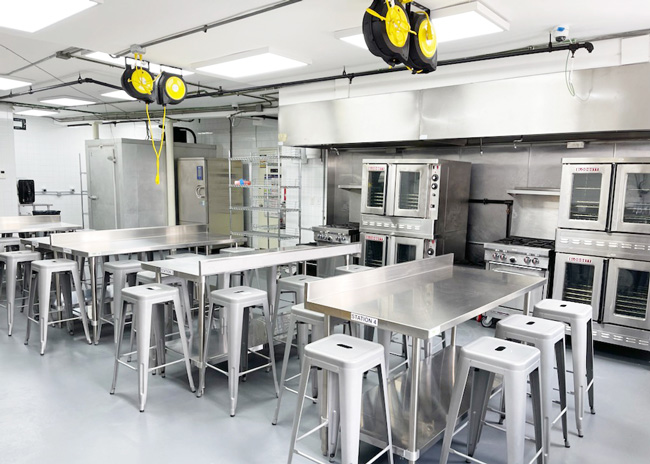Ever heard of the term “flex kitchen?” That was new to me when Bella Karakis, CEO, founder e.terra, first introduced the concept.
 Images courtesy of e.terraFlex kitchens are similar to shared kitchens or shared commissaries, but what’s different about these is the flexibility they offer – both in terms of agreements with entrepreneurs and in equipment so they can accommodate a more diverse group of uses.
Images courtesy of e.terraFlex kitchens are similar to shared kitchens or shared commissaries, but what’s different about these is the flexibility they offer – both in terms of agreements with entrepreneurs and in equipment so they can accommodate a more diverse group of uses.
“We are able to help a food company flex up or down as necessary on a short-term or month-to-month basis,” Karakis says. “If one month a caterer has three weddings in addition to a smaller, off-premises event, they can increase their hours. If the next month they only have one small event they can decrease their hours in the kitchen for as low as $20 per hour.
The flexible option also helps startup entrepreneurs or others use the kitchen as needed to test menus and develop concepts here and there before they need to ramp up production. “The ‘a la carte’ option was truly born out of the pandemic and a necessity for caterers and others struggling to have that steady business,” Karakis says.
Other users of e.terra include bakers, food developers, meal prep companies, delivery-only/ghost kitchen concept developers and anyone else in need of a commercial kitchen. There’s even a private school customer that has been using the kitchen five days a week to produce 350 meals for the student body while the school’s cafeteria undergoes a complete renovation. The kitchens are also used by a small ghost kitchen operation looking to expand the delivery zone and begin to scale up without the extra costs of investing in its own kitchen space.

Flex Kitchen Equipment
To support the diversity of the e.terra customer base, Karakis and co-founder/chief financial officer Joel Rogozinski focused on selecting the most “flexible” equipment possible.
 “We offer customizable dry, cold and freezer storage, from as little as a shelf on a rack to a full rack to sheet racks to cages,” Karakis says. Everything is fully adjustable and mobile so users can use as much or little storage options as needed.
“We offer customizable dry, cold and freezer storage, from as little as a shelf on a rack to a full rack to sheet racks to cages,” Karakis says. Everything is fully adjustable and mobile so users can use as much or little storage options as needed.
The wide-open, 5,500-square-foot layout of the flex kitchen also allows for the mobility of prep tables and cooking lines. Prep tables are positioned as close to each of the 11 hot lines and three cold stations as possible to meet health department requirements for the different operations. The space can handle up to 14 different operations with up to three people each working at the same time, Rogozinski says.
There are redundancies created so each hot line has stoves, ovens and fryers that can fit under the hood systems, and then there is a separate area with high volume equipment like a tilt skillet, steam kettles and grills that can be reserved for use. There are also a few combi ovens in this area to provide further flexibility. “That is one area where we’re different; there are other shared kitchens in New York City but none that I know of that have combi ovens.”
Says Rogozinski, “how you outfit a kitchen space like ours is who you’re going to attract. The more specialized equipment we offer allows us to attract entrepreneurs that might not have access to some of these pieces, or because they don’t have the startup funds to buy them.” School foodservice, catering and bakers in particular flock to the combi ovens in order to achieve consistency in product.
 Most recently, the team installed a large blast chiller to help e.terra customers cool food down properly without resorting to improper cooling methods (like putting large batches of hot soup in a walk-in cooler or freezer). This equipment also allows users to ramp up production with less time, Rogozinski says.
Most recently, the team installed a large blast chiller to help e.terra customers cool food down properly without resorting to improper cooling methods (like putting large batches of hot soup in a walk-in cooler or freezer). This equipment also allows users to ramp up production with less time, Rogozinski says.
To reserve equipment and space, e.terra uses a specialized scheduling and billing software platform that’s accessible online. The flex kitchen also uses technology to trace different users of the space to maintain health department records.
“Another thing we offer is delivery acceptance – someone is always working during the day and at night, so we’re able to accept deliveries for our customer at any time,” says Karakis, who adds that e.terra maintains partnerships with major distributors to offer its customers extra buying power. On different occasions, experts in various fields have been brought in to offer consulting for e.terra customers.
The e.terra team is currently working on building out a second location, this one in Harlem with designated parking. Rogozinski says the team hopes to expand their use of technology in the second space to further support ghost kitchen operations. “One technology that we’re looking to implement is adding QR codes in an office building, for example, which will bring up all the menus of the operations in the kitchen at that time, and customers would be able to order from them right then and there,” he says. “Having those technological solutions helps bridge some of those gaps of being a small entrepreneur. For us it’s about helping our members make money while saving money. Because when our members make money, we make money.”



